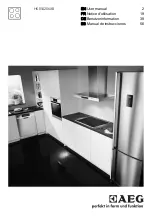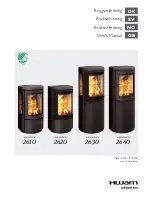
ENGLISH
26
A:
insulated steel chimney flue
B:
minimum height 1.5 m
C-E:
room air inlet (minimum internal cross-section 80
cm²)
D:
steel chimney flue inside existing masonry chimney flue
Refer to local regulations in the country of use for anything that is not specifically covered in this manual. In Italy, refer to standards
UNI 10683/2005 and UNI 10412-2, as well as the Ministerial Decree No. 37, ex Law No. 46/90, in addition to any Regional or Local
Health Authority regulations. If installing in a block of apartments, first consult the block administrator.
Verify compatibility with other devices
According to standard UNI 10683/2005, the thermal stove must NOT be installed in the same room as extractors, type A and B gas
appliances and, in any case, devices that diminish the ventilation inside the room.
Verify the electrical connection
(THE PLUG MUST BE ACCESSIBLE)
The thermal stove is supplied with a power cable that is to be connected to a 230V 50 Hz
socket, preferably with a magnetothermic switch. Voltage variations exceeding 10% can
damage the thermal stove (unless already installed, an appropriate differential switch
must be fitted). The electrical system must comply with law; particularly verify the
efficiency of the earthing system. The power line must have suitable cross-section for
the stove’s power.
Positioning
The thermal stove must be level for it to function correctly.
Verify the bearing capacity of the floor.
Fire prevention safety distances
The thermal stove must be installed in compliance with the following safety conditions:
- medium flammability items must be kept at a minimum distance of 40 cm from the sides and back of the thermal stove
- highly flammable items must be kept at a minimum distance of 80 cm if placed in front of the thermal stove
- if the thermal stove is installed on flammable flooring, a sheet of heat insulating material must be placed on the floor. This must
extend at least 20 cm from the sides and 40 cm from the front.
Flammable objects must not be placed above the thermal stove or at a distance that is any less than the stipulated safety distances.
If connected to wooden walls or other flammable materials, the smoke exhaust pipe must be appropriately insulated with ceramic
fibre or other similar material.
Air inlet
The room where the thermal stove is placed must have an air inlet with a cross-section of at least 80 cm2 so as to guarantee sufficient
air supply to the stove for combustion.
Smoke outlet
The discharge system must only be used for the thermal stove (the smoke cannot be discharged into a chimney flue used by other
devices).
The smoke is discharged through the 8 cm diameter outlet at the back of the thermal stove. A T-junction must be set up with a
condensation collection stopper at the beginning of the vertical section. The thermal stove smoke discharge must be connected with
outside by means of steel or black pipes (resistant to 450 °C) and free from obstructions.
The pipe must be hermetically sealed. The material used to seal and if necessary insulate the pipes, must be resistant to at least 300
°C (high temperature silicone or mastic).
The horizontal sections can be no more than 2 m long. The horizontal section must have a minimum inclination of 3% and a
maximum of two 90° bends.
If the outlet is not fitted into a chimney flue, a vertical section of at least 1.5 m will be required, complete with a wind guard.
The vertical duct can be internal or external. If the smoke channel is outside, it must be insulated.
If the smoke channel is fitted inside a chimney flue, the latter must be suitable for solid fuel. If it is wider than 150 mm in diameter,
a pipe must be entered and the outlet sealed to the masonry.
All sections of the smoke duct must be accessible for
inspection.
INSTALLATION
Distance from flammable material
Floor protection
sk tecnica mimì-norma multilingue vers C 30 11 2010.qxp 30/11/2010 15.27 Pagina 27
















































